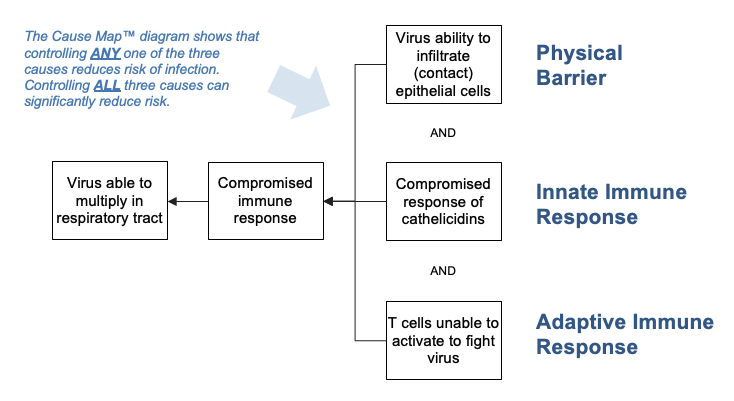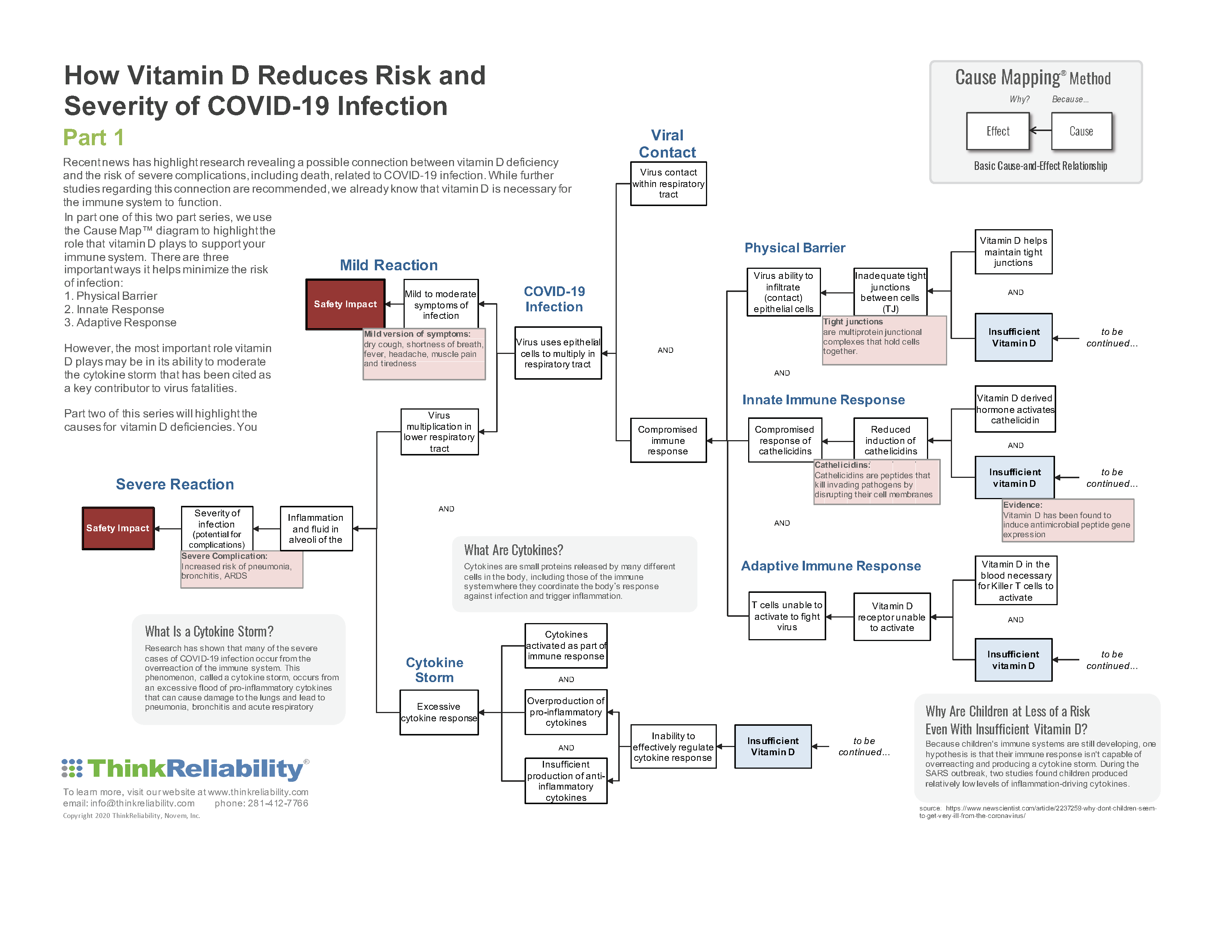Recent studies are beginning to draw a connection between low vitamin D levels and risks associated with COVID-19 infection. In fact, one such study from Trinity College in Dublin recently suggested the Irish government should recommend vitamin D supplements to residents because of the link between vitamin D deficiencies and mortality from COVID-19. For many weeks now, I have been analyzing how vitamin D supports the immune system. While research related to the novel coronavirus is still new, there has been a significant amount of research conducted highlighting the role of vitamin D in supporting the immune system, and specifically, its ability to reduce risk of respiratory illnesses such as the influenza and the common cold.
By understanding the causal relationships involved, we’re able to evaluate whether the same lessons could apply to COVID-19. Using the Cause Map™ diagram, I am able to show specifically how vitamin D is critical in activating your immune response, but also controlling it to avoid an immune response overreaction called a cytokine storm.
3 Key Mechanisms for Vitamin D that Support Immune System
To better understand the role of vitamin D, we need to start with a brief overview regarding cellular biology. Cells in your body have receptors that provide a way for communicating and interacting. In fact, a virus will use the receptors to get a ride into your body and attack cells.
Vitamin D plays a critical role in the health and viability of our immune system. There have been a number of other cross-sectional studies looking at vitamin D levels and rates of influenza. All have reported an association of lower vitamin D levels and increased rates of infection. Research related to other respiratory illnesses identified three mechanisms in which vitamin D plays a role in preventing infection. They are:
- Physical Barrier
- Innate Response
- Adaptive Response

The cause-and-effect relationships in the Cause Map™ diagram above highlight three ways vitamin D supports your immune system in fighting the virus. As a physical barrier, vitamin D supports the tight junctions between the cells within your respiratory tract. Tighter junctions mean less space for the virus to fit through, thus reducing the ability of the virus to infiltrate and make contact to cause infection.
Vitamin D is also critical for your innate (non-specific) immune response by inducing the activation of cathelicidins. Cathelicidins work to immediately kill foreign pathogens by disrupting their membrane. Studies have shown that transcription of cathelicidin is absolutely dependent on sufficient vitamin D.
A third benefit of the vitamin D is its role in activating Killer T cells. These cells, which are part of the adaptive (specific) response, are provided fragments or traces of the virus, so that they can search and destroy any cells that have been compromised by the virus. Scientists at the University of Copenhagen discovered that vitamin D is crucial to activating those Killer T cells, and they would “remain dormant, or “naïve” to the possibility of threat if vitamin D is lacking in the blood.”
Stopping a Cytokine Storm
In addition to the three benefits already cited, ironically, the most important role of vitamin D in the fight against COVID-19 might just be its ability to control and essentially “pump the brakes” on the immune response. This might explain why some people have mild complications versus those who have a severe, and sometimes fatal, result. The term used to describe this phenomena is a cytokine storm. Cytokines are small proteins released by many different cells that coordinate the body’s response against infection and trigger inflammation. Research has shown that many of the severe cases of COVID-19 infection occur from the over production of pro-inflammatory cytokines as a response to infection. This overreaction causes a flood of inflammation in the lungs that can cause damage and lead to pneumonia and acute respiratory distress syndrome (ARDS). There are also anti-inflammatory cytokines that will work to control and suppress the body’s response. Several studies have shown that sufficient vitamin D is necessary to the production of these anti-inflammatory cytokines and the ability to inhibit monocyte production of inflammatory cytokines. As the Cause Map diagram below demonstrates, these three factors play a role in the overall cytokine response to infection.
One argument made against the role of vitamin D and its ability to reduce the risk of COVID-19 infection is that young children who tend to be deficient in vitamin D seem to be unaffected by the virus, compared to adults. However, this could be explained by the maturity of their immune system. Because children's immune systems are still developing, one hypothesis is that their immune response isn't capable of overreacting and producing the cytokine storm described above. In fact, during the 2003 SARS outbreak, two studies found children produced relatively low levels of inflammation-driving cytokines.
On the detailed Cause Map diagram below, you can see how each cause-and-effect relationship shows the role of vitamin D in these different parts of the immune system. Next week, my blog will answer the next Why question of why you may have a vitamin D deficiency.
The Cause Mapping method of root cause analysis provides a visual way to analyze the cause-and-effect relationships within an incident to find more effective solution options for work process improvements and risk reduction. Just as it helps us better understand how vitamin D may reduce the risk of COVID-19 infection, utilizing a Cause Map diagram can provide insights into issues across industries. For more in-depth training on the Cause Mapping method of root cause analysis, consider one of our upcoming free webinars, online short courses or online workshops.












